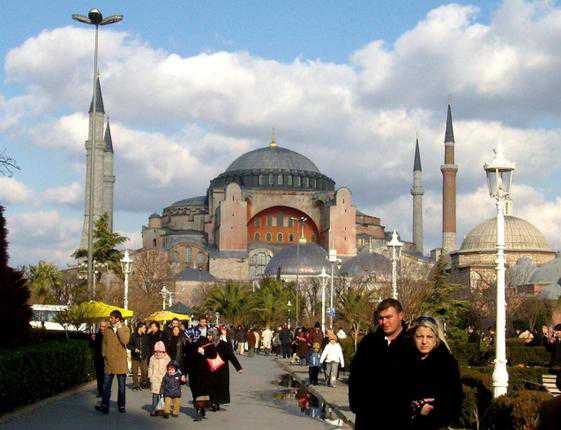
Colourful History Hagia Sophia
The Hindu Haggling in Grand Bazaar
Worshippers in the dramatic interiors of the the Blue Mosque
A city that does not just attract you but grabs you by the hair and mesmerises you.
I am standing in the heart of Istanbul, a magical city that’s been the cradle of many civilisations. My senses are teased from all directions. The sound of the evening call comes to my ears from the Suleyman mosque, competing with vendors’ cries and self-styled tour operators advertising boat rides on the Bosphorus. The fishy smell of the seaside, thick and cloying, mingles with the burnt smell of corn and roasted chestnuts, the most common street snack in Turkey.
Colours assail my eyes. The bright blue of the sky, the aquamarine of the Bosphorus, the brown and deep blue of the mosque domes, multi-coloured boats carrying excited tourists and their clicking cameras… Istanbul does not just get to you. It grabs you by the hair. It possesses you. And never lets you go.
Istanbul is divided by the greater horn estuary into a north-western part called Beyoglu and a south-eastern part called Eminonu. Beyoglu is dominated by the Dohlmabahce Palace, while Eminonu has 2000 years of history clustered into the one-square-mile Saultan Ahmet Square, with Hagia Sophia, the Blue Mosque, Topkapi Palace, and Basilica Cistern.
My first stop is Topkapi Palace, one of the largest castles in the world and the official residence of the Ottoman Sultans for nearly 400 years. Over centuries, the Sultans gathered works of art from the distant outreaches of their empire. Some fascinating pieces include the staff of Moses, with which he is said to have parted the Red Sea; the sword of Abu Bakr, first Caliph and father-in-law of Prophet Mohammed, the sword of Ali Bin Talib, son-in-law of the Prophet; besides my personal favourites — the mantle of the Prophet, his footprint preserved in silver, and hairs from the prophet’s beard. I had goose bumps all over my body when I saw these holy relics carefully preserved for over a millennium and a half.
There are other attractions, like the meandering harem quarters (incidentally, ‘meander’ is derived from the Turkish river Mender) where legend says Turkish rulers housed Hungarian, Romanian and Russian women, preferring them to Turkish beauties.
At Hagia Sophia, I discover that the English football hooliganism is nothing new, being at least 15 centuries old. The games at Constantinople took place in the hippodrome, and in the sixth century, when their team lost a major game, crazed fans attacked and destroyed the beautiful Hagia Sophia, a huge wooden church that Constantine’s successors had built. In retaliation, the Emperor called the fans into the hippodrome and had every one of them executed. Since they constituted 10 per cent of the population, the punishment was called decimation.
The new Hagia Sophia was built over five years and is a masterpiece of early Christianity, with stained glass windows, marble columns, and fabulous gold-layered mosaics. What an example of tolerance — when the Ottomans overran Constantinople, they destroyed no churches but converted them into mosques instead, principally by adding minarets and changing the centre of the apse to face Mecca. No frescoes or mosaics were destroyed; instead, since Islam prohibited image worship, a thin layer of plaster was put on the surface of the mosaics. The plaster was taken off by the new secular Turkish government and I had the rare pleasure of seeing the face of an angel revealed after 11 years of hard work.
It was in recognition of 900 years of Christianity and 500 years of Islam vibrating together in the same hall that Ataturk, the father of modern Turkey, declared the monument a museum, and opened it to the whole world.
The Blue Mosque is a charming, yet massive structure. Built to pay tribute to Allah, it’s the only mosque with six minarets. Incidentally, the Hagia Sophia is the only mosque with four dissimilar minarets. The interiors of the blue mosque have 21,043 hand-painted blue tiles, giving a distinct blue colour to the inner dome. Although prayers continue through the day, tourists are allowed free access. In the soft evening light, as we left the blue mosque, the musical call of the muezzin was nectar to our ears as the day gently pulled us away.
Another feature of the blue mosque that delighted me was the presence of four large medallions on the corners of the central hall. While two medallions carry the names Abu Bakr and Ali Bin Talib, the other two have the names Hussain and Hassan. This, in contemporary Islam, is very rare and one that I have not known to exist in any other mosque. The Prophet’s grandson Hussain and his father-in-law Abu Bakr’s descendants had a bloody series of clashes leading to Hussain’s death at Kerbala. And thousands of innocent Muslims have been killed in the ongoing schism between Shia and Sunni factions, including the Kurd massacre by Saddam Hussein. What better way to preach brotherhood than a visit to the blue mosque?
QUICK GUIDE
MUST VISIT
Istanbul Archaeology Museum, one of the five largest in the world with nearly a million pieces
Istanbul’s Kapaliçarsi or Grand Bazaar, dating back to 1461, with over 4,000 shops
MUST BUY
Hand-knotted carpets or kilims, often sold as pillowcases, bags or boots
Hand-painted quartz or ceramic tiles
MUST EAT
Simit, a light, fluffy bread topped with sesame with Sahlab, a hot and cinnamony milk tea
Turkish Delight, or Lokum, of course!
Keywords: Turkey, Istanbul Archaeology Museum, Blue Mosque
via The Hindu : Metroplus / Travel : Istanbul and its old world charm.

Leave a Reply